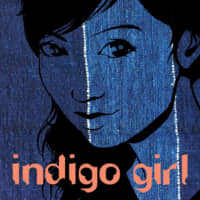The sequel to "Gadget Girl" (GemmaMedia, 2013), this book continues the story of Aiko, a bicultural teenager with cerebral palsy and a passion for drawing manga. While fans will be pleased to see a natural progression of "Gadget Girl," those meeting Aiko for the first time in "Indigo Girl" will be in no way disadvantaged.
Indigo Girl, by Suzanne Kamata.
240 pages
GEMMAMEDIA, Fiction.
After growing up with her American mother in a "testosterone-free zone," as she wryly observes, Aiko's family has now expanded to include a stepfather and baby half sister, and the 15-year-old is questioning her place in this new order. She is excited about a summer trip to Japan, and the chance to meet her biological father for the first time, and to try on a new family for size. The reality, of course, is not what Aiko expects.
Her father is one of the few remaining farmers in Shikoku who grows and harvests indigo plants. Against the backdrop of life in this traditional area of Japan, Aiko gets to know her extended Japanese family and starts piecing together elements of her own complicated personal history. Author Suzanne Kamata includes enough detail to satisfy any curiosity about life in Japan as seen through her heroine's eyes, but it never weighs on the story.
Like many people her age, the forthright Aiko has a tendency to see things in black-and-white, but she begins to realize that family relationships can be as nuanced as the colors produced from her father's indigo plants. Kamata's talent for pithy dialogue, coupled with the sensitive portrayal of teenage life, make this another winner for the Shikoku-based writer.



















With your current subscription plan you can comment on stories. However, before writing your first comment, please create a display name in the Profile section of your subscriber account page.